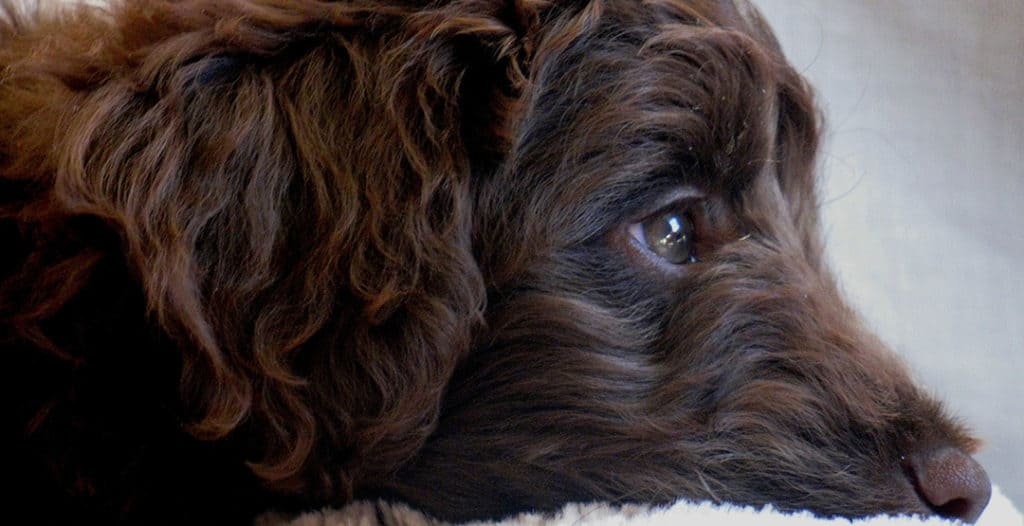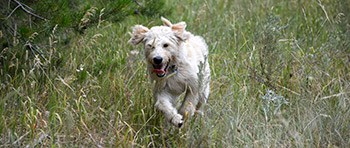
Few things can take away from the appearance of a well-groomed dog quicker than eye boogers and discharge. While this may be something simple and harmless, it can also be the sign of something more serious.
Just what causes eye boogers and discharge in Labradoodle puppies? Eye boogers or eye crust is common with most dog breeds. When dust and dirt get in their eyes, fluid rinses the debris from the eye. When this accumulates outside their eye, it forms eye boogers. Eye boogers are usually black in color and harden in the corners of their eyes, closest to their muzzle. Eye discharge can occur for various reasons and generally takes on a different appearance than normal eye boogers. While it may be something totally harmless, it can also be the sign of a health issue needing veterinarian care. Here are some possible causes that could be problematic for your Labradoodle puppy.
- Allergies
- Routine environmental irritants
- Conjunctivitis
- Epiphora (dog tears)
- Glaucoma
- Keratoconjunctivitis Sicca (dry eye)
As an owner of 2 Labradoodles myself, I know how tough it can be to find good information. In the 60+ pages of this book, I share the information, resources, and breed-specific tips I wish I’d had from the start. You will save you time, money, and loads of frustration…take my word for it!
Difference Between Eye Crusts (Boogers) And Eye Discharge
Eye discharge and eye boogers are very similar in that they are both in your dog’s eyes and they both can negatively affect the dog’s appearance. Eye discharge is usually more in a liquid form almost like tears.
Boogers are usually eyes crusts. They may also be slimy things that sit in the corner of the dog’s eyes or around the edges. It’s often very similar to what we have and describe as “sleep in our eyes”. Depending on what’s causing boogers or discharge, you may find that you can wipe the dog’s eyes clean only to discover new boogers and crusts in the eyes an hour later.
When To Be Concerned
As a puppy owner, you want to give your dog the best possible care, but sometimes it’s hard to know if something like boogers and discharge is normal or cause for concern. There are various types of discharge, and different things often cause them. Frequently, if you’re able to identify the type of discharge or boogers, you’re in a better position to determine if it’s something you should be concerned about.
A Little Crust or Goop – Tears are an important part of good eye care for your dog. Tears provide nourishment and oxygen to the cornea and help get rid of debris and dust that can be become trapped in the eye. Sometimes the tears that naturally flow tend to become crusted around the eyes particularly in the morning or after a long daytime nap. It should be easily removed. If it’s not, or there is too much, you should call or visit a vet.
Red/Brown Tear Stains – Tear stains that are reddish-brown are quite common in light-colored Labradoodles. This happens because these tears have a pigment that turns dark when exposed to air for any length of time. This can also be caused by a yeast infection on the face. Wiping the eyes and surrounding area with a warm damp cloth or eye cleaner should take care of the stains. If not, or the eyes become painful, see a vet.
Watery and clear – Various conditions can cause excessive eye-watering, including blocked tear ducts, irritants, allergies, corneal wounds, anatomical abnormalities or glaucoma. If there is a slight increase in tears, but your puppy doesn’t seem to be bothered by it, I would let it run its course. If it seems to be increasing and/or the dog’s eyes seem to be red or painful, a trip to the vet is in order.
Whitish Gray Mucus – This is often caused by dry eye, a condition that develops if the dog’s immune system destroys the tear-producing glands. The body overcompensates for the lack of tears by creating more mucus to lubricate the dog’s eyes. The dog should be seen by a vet to prevent eventual blindness.
Green or Yellow Discharge – If your Labradoodle has green or yellow discharge, this is usually a sign of an eye infection, especially if it’s accompanied by discomfort and eye redness. What starts as a small eye infection can develop into something more serious, so have a vet examine your dog.
Preventing Eye Boogers And Discharge
If you stop and consider how many times a day we rub our eyes, particularly when we’re outside, it’s easy to understand how a dog might get eye boogers or discharge. They don’t have the luxury of being able to rub their eyes, run cool water in their eyes or squirt in some Visine.
They have to just deal with allergens, dirt, dust or what have you and hope that we keep their eyes clean. As much of an effort as they make to clean themselves, their eyes are one part of their bodies they cannot clean themselves. Here are a few ways you can prevent eye discharge and boogers in your Labradoodle puppy.
- Keep the hair trimmed around the dog’s eyes.
- Be careful when using items that can irritate your dog’s eyes, such as dust, shampoo or insect repellent.
- You can use dog eye wipes to clean your dog’s eyes.
- Observe your dog and his surroundings to see if there are things that are bothering his eyes on a regular basis. If so, try to avoid these things.
- Make sure the dog’s face is kept as clean as possible.
- If the dog’s eyes have more gunk than normal, have the dog checked by a vet.
- Make sure the dog is eating a healthy diet in clean (non-plastic) dishes and receives fresh water daily.
As an owner, you should make it a regular routine to give them a good once-over. Check their mouth for sore or abnormalities, check their body for lumps or pests like ticks, look in their eyes, and examine their paws for cuts or abrasions. It’s your responsibility to be the advocate for your pup and notice when something isn’t right.
What Causes Eyes Staining In Dogs?
Many things can cause eye staining. As mentioned above, the type or color of discharge can often be a good indication of the cause or what can be developing. Eye staining is usually caused by excessive tear production, but it can also be an indication of a serious eye problem. Certain dogs are more prone to tear staining, and poodles are one of those dog breeds.
Considering that Labradoodles are at least 50% poodle, it’s not unusual to have a Labradoodle with an eye staining problem. The lighter the color of the dog’s coat, the more noticeable the staining will be. Unsanitary conditions can also cause eye staining as can eating out of plastic bowls. Here are some medical causes of tear staining.
- Unusually large tear glands
- Unusually small tear duct openings
- Stress
- Teething in pups
- Glaucoma or another eye disease
- Inverted eyelid
- Ingrown eyelashes
- Eye infection
- Ear infection
- Low-quality diet
- Exposure to second-hand smoke
- Brachycephalic syndrome
All these conditions listed are not meant to say your Labradoodle is suffering from a serious medical condition. It’s just for a guideline in case your Labradoodle does seem to have excessive eye boogers, discharge and staining, and you’ve ruled out the minor things that could be causing it. If it’s not something serious, but you are concerned, it’s worth mentioning at the dog’s next checkup.
How To Clean Dog Eye Stains
Cleaning eye stains is a relatively easy process and one that should be done daily if not a few times a day. Dampen a cloth with warm water and gently wipe around the eyes until the discharge is removed. The more often you do this, the more your dog will get used to having it done. There are also several commercial products you can use to treat tear staining. Dog eye wipes are also helpful. In some cases, you may want to give the dog oral medications to help with visible tear staining.
If your dog has been eating in plastic bowls, toss them out and replace them with stainless steel bowls. Some Labradoodle owners use filtered water, which they feel helps reduce eye staining.
Related Questions
Can dogs wear glasses or contacts?
Surprisingly enough, dogs can wear glasses or contacts. A few companies do make prescription glasses for dogs, although dogs are generally not happy about wearing them. Contact lenses have been used in some cases to help a dog see better. However, most of the time they’re used as a healing aid or band-aid for dogs who are being treated for ulcers or glaucoma.
Can you prevent cataracts in dogs?
In most cases, you can’t prevent your dog from developing cataracts, but you can take steps to help your dog preserve his eyesight if he does develop cataracts or is prone to cataracts. The first step in monitoring the dog’s eyes and taking the dog to the vet regularly.
In Summary….
Grooming your Labradoodle puppy is probably a daily routine for the two of you. While doing this, pay special attention to your dog’s eyes and wash them gently from time to time. The best way to ensure your puppy always has the same adorable healthy puppy eyes you fell in love with is to take care of them when needed!





